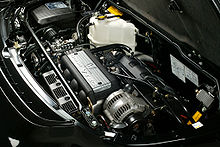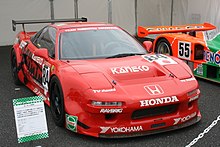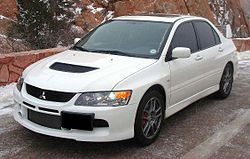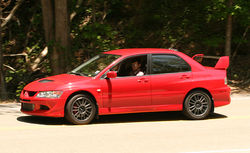Development
In 1984 Honda commissioned the Italian car designer Pininfarina to design the HP-X (Honda Pininfarina Xperimental),[1] which had a mid-mounted 2.0 L V6 configuration.After Honda decided to pursue the project its management informed its engineers that the new car would have to be as good as anything coming from Italy and Germany.[2] The HP-X concept car evolved into the NS-X (New Sportscar eXperimental) prototype. The NS-X prototype and eventual production car were designed by a team led by Chief Designer Ken Okuyama and Executive Chief Engineer Shigeru Uehara, who subsequently would be placed in charge of the S2000 project. The original performance target for the NS-X was the Ferrari 328, which was revised to the 348 as the design neared completion. Honda intended the NS-X to meet or exceed the performance of the Ferrari, while offering targeted reliability and a lower price point. For this reason, the 2.0L V6 of the HP-X was abandoned and replaced with a more powerful 3.0L VTEC V6 engine. The bodywork design had been specifically researched by Okuyuma and Uehara after studying the 360 degree visibility inside an F-16 fighter jet cockpit.[3] The NS-X was designed to showcase several Honda automotive technologies, many derived from its F1 motor-sports program.
The NS-X was the first production car to feature an all-aluminum monocoque body,[4] incorporating a revolutionary extruded aluminum alloy frame, and suspension. The use of aluminum in the body alone saved nearly 200 kg in weight over the steel equivalent while the aluminum suspension saved an additional 20 kg; a suspension compliance pivot helped maintain wheel alignment changes at a near zero value.[5] Other notable features included an independent, 4-channel anti-lock brake system; titanium connecting rods in the engine to permit reliable high-rpm operation; an electric power steering system;[6] Honda's proprietary VTEC variable valve timing system (a first in the US) and, in 1995, the first electronic throttle control fitted to a Honda.
Honda spent a great deal of time and money developing the NS-X. With a robust motorsports apparatus, Honda had significant development resources at its disposal and made extensive use of them. Respected Japanese Formula One driver Satoru Nakajima, for example, was involved with Honda in the NS-X's early on track development at Suzuka race circuit, where he performed many endurance distance duties related to chassis tuning. Brazilian Formula One World Champion Ayrton Senna, for whom Honda had powered all three of his world championship-winning Formula One race cars before his death in 1994, was considered Honda's main innovator in convincing the company to stiffen the NSX chassis further after testing the car at Honda's Suzuka GP circuit in Japan. American Bobby Rahal also participated in the car's development.[7] Senna was given an NSX by Honda, although details of this car and its fate are unclear.[citation needed]
The production car made its first public appearances as the NS-X at the Chicago Auto Show in February 1989, and at the Tokyo Motor Show in October 1989 to positive reviews. Sports car enthusiasts focused their attention on its low height, body lines, and pronounced forward cockpit. Honda revised the vehicle's name from NS-X to NSX before final production and sale. The Honda NSX went on sale in Japan in 1990. The NSX was sold under Honda's flagship Acura luxury brand starting in 1991 in North America and Hong Kong.
[edit] Manufacture and release
Upon its release in 1990, the NSX design concept measured 1,170 mm (46 in) in height, (only 141.3 mm (5.56 in) taller than the legendary Ford GT40), and showcased Honda's technology. The Japanese car maker's race track innovations and competitive history were further exemplified on the road by the NSX's ultra-rigid, ultra-light all aluminum monocoque chassis and front and rear double wishbone suspension, with forged control arms connected to forged alloy wheels. The car additionally boasted the world's first production car engine with titanium connecting rods, forged pistons, and ultra high-revving capabilities — the redline was at a lofty 8,000 rpm - all traits usually associated with track and race engineered motor cars. The NSX exterior had a dedicated 23-step paint process, including an aircraft type chromate coating designed for chemically protecting the aluminum bodywork and a waterborne paint for the base coat to achieve a clearer, more vivid top color and a smoother surface finish.The car's strong chassis rigidity and cornering/handling capabilities were the results of Ayrton Senna's direct input with NSX's chief engineers while testing the NSX prototype car at Honda's Suzuka Circuit during its final development stages.[7] The NSX was initially assembled at the purpose-built Takanezawa R&D Plant in Tochigi from 1989 to early 2004, when it was moved to Suzuka Plant for the remainder of its production life. The cars were assembled by approximately 200 of Honda's highest-skilled and most experienced personnel, a team of hand-picked staff with a minimum of ten years assembly experience employed from various other Honda facilities to run the NSX operation.[2] After studying their main competitors such as Ferrari, Lamborghini and Porsche, Honda engineers designed the NSX in search of the "perfect balance" between usable power and reliability and thus produced a powerful naturally aspirated VTEC engine suitable for the extreme demands of both road and track.
One of the first magazine articles to offer NSX test data showed the lightweight 3.0L 270 bhp (200 kW) NSX producing a best 0-60 mp/h time of 5.03 seconds and 13.47 seconds for the quarter mile.[8] Also on a Ferrari 348 to NSX comparison, a 0-60 mph time of 5.2 seconds was recorded for the 1991 NSX.[9]
Wheels magazine Australia awarded the Honda NSX the 1991 Car of the Year award, and the Acura-badged car was Automobile Magazine's Automobile of the Year that same year.
Today the NSX is still considered by owners of the marque as one of the most reliable exotic cars ever manufactured, with many examples exceeding 100,000 miles (160,000 km) without serious notable reliability issues or having suffered manufacturer recalls. Despite the original NSX ceasing production in 2005, the marque still has a strong base of fans and supporters worldwide with owners clubs flourishing in Asia, the USA and across Europe.[citation needed] International motoring authors like Andrew Frankel (AutoCar & Motor) Russell Bulgin (Car) Mark Hales (Fast Lane) Gianni Marin (Gente Motore) and Bernd Ostmann (AutoMotor Und Sport) have not only lent their name to the NSX in print but publicly praised the technology and innovation of Honda's NSX and in the BBC book NSX - Hondas Super Sports Car (ISBN 0 9517751 0 3) describe the vehicle as worthy of the title supercar.
Post-1997 3.2 L North American Acura examples are known to achieve a 13.3 second quarter-mile time [10] (1997-2005 model year NSX-T; the 149 lb (68 kg) lighter Zanardi Edition NSX is closer to 13.2 seconds [11]), while the Japanese NSX-R (2002+) is known to perform a 12.8 second quarter-mile time as measured by Japan's "Best Motoring" tv show.[citation needed] This ability is a result of the high redline, flat torque curve, short gear ratios, light weight and mid-engine layout, along with the light power increase.
First generation NSX-R (JDM)
While the NSX always was intended to be a world-class sports car, engineers had made some compromises in order to strike a suitable balance between raw performance and daily driveability. For those NSX customers seeking a no-compromise racing experience, Honda decided in 1992 to produce a version of the NSX specifically modified for superior on-track performance at the expense of customary creature comforts. Thus, the NSX Type R (or NSX-R) was born. Honda chose to use its moniker of Type-R to designate the NSX-R's race-oriented design.Honda engineers started with a base NSX coupe and embarked on an aggressive program of weight reduction. Sound deadening, the audio system and the entire air conditioning system were removed. The power leather seats were replaced with lightweight carbon fiber racing seats manufactured for Honda by Recaro. The stock alloy wheels were replaced with forged aluminum wheels produced by Enkei, which reduced the car's unsprung weight. The stock leather shift knob was replaced with a sculpted titanium piece. Overall, Honda managed to remove approximately 120 kg (265 lb) of weight, giving the NSX-R a final weight of 1,230 kg (2,712 lb).
Turning to the suspension, it was well known by 1992 that the NSX, due to its mid-engine layout and rear-end link travel, was susceptible to a sudden oversteer condition during certain cornering maneuvers. While this condition rarely occurred during spirited street driving, it was much more prevalent on race tracks where speeds were much higher. To address the problem and improve the NSX-R's cornering stability at the limit, Honda replaced the entire suspension with completely new springs and dampers.
The stock NSX has a rear bias in its spring rates, where the rear springs are stiffer than the front. On hard deceleration upon corner entry, the softer front springs allow weight transfer to the front wheels, increasing front grip and thus improving steering response. However, the weight transfer also takes weight off of the rear wheels, causing them to lose grip. The net result is a tendency toward oversteer, as the rear wheels are more likely to break traction and cause a fishtail (drift) or spin. For the NSX-R, Honda reversed the spring bias, placing stiffer springs on the front suspension. This had the effect of preventing weight transfer to the front suspension under hard braking. This way, the rear tires would remain firmly set when entering the corner. Of course, by keeping weight off of the front wheels, front grip was reduced and the change therefore had the negative effect of increasing the understeer tendency of the car. This change required better driver skill to manage. Overall, the NSX-R uses much stiffer springs than the stock NSX (F 3.0 kg/mm—R 4.0 kg/mm for the NSX versus F 8.0 kg/mm—R 5.7 kg/mm for the NSX-R).
Honda also increased the final drive ratio by adding a 4.235:1 ring and pinion gear in place of the 4.06:1 stock unit, which moved the NSX-R's shifts further into the power band at the expense of top end performance.
The lightest of all NSX variants at 1,230 kg (2,712 lb), the First-Gen NSX-R is capable of blistering track performance, though the ride can be jarring and noisy due to the stiff spring rates and lack of sound insulation.
Beginning in 1992, Honda produced a limited number of 483 NSX-R variants exclusively for the Japanese domestic market (JDM). Air conditioning and the stereo system were available for a hefty premium as optional items. Production ended in 1995.
NSX-T
In 1995 the NSX-T with a targa top roof was released in Japan as a special order option. In North America, the NSX-T replaced the standard coupe entirely as the only trim available, with the notable exceptions of the Zanardi Edition NSX in 1999 and a handful of special ordered post-1997/pre-2002 3.2 liter coupes. The removable roof reduced the chassis rigidity of the NSX and added about 100 pounds (45 kg) of structural reinforcements. In addition to this major change, the suspensions have also been softened to improve ride, comfort, and tire wear, at the ultimate expense of handling. The suspension redesign was also intended to reduce the sudden-oversteer problems that plagued most mid-engined vehicles. All roofs were now body-colored instead of black, although in Japan the two-tone black roof/body color was still available as an optional feature. Finally available in the manual transmission version NSX was electric power steering, previously found in the automatic version exclusively.[edit] 1997 performance-enhancing changes (Worldwide)
1997 brought the biggest changes to the performance of the current generation NSX for the Japanese domestic versions and abroad. For 1997 engine displacement increased from 3.0 L to 3.2 L using a thinner fiber-reinforced metal (FRM) cylinder liner. This revised 3.2 L C32B engine gave it slightly more rated power: from 274 PS (202 kW; 270 hp) to 294 PS (216 kW; 290 hp) while torque increased from 285 N·m (210 lb·ft) to 305 N·m (225 lb·ft) (manual transmission only). The 4-speed automatic model still used the 3.0 L engine and power output. Another big change was the adoption of the 6-speed manual transmission. The combination of slightly-increased power and torque, 6-speed manual gearbox, and optimized gear ratio produced improved straight-line acceleration. The new NSX rang up better numbers than the power and torque improvements may suggest over previous model NSXs. 0-60 mph times dropped from 5.2 to as low as 4.5 as recorded by Car and Driver in their August 1998 0-150-0 issue using a 3.2 hard top coupe. That NSX proved to be the fastest tested in North America. When Car and Driver tested the Zanardi special edition NSX a year it managed a 4.8 0-60 and a 13.2 quarter mile. Although magazine tests for the 02+ models were rare Honda apparently kept improving the engine as Sports and Exotic Car magazine did a farewell article on a 2005 NSX-T and recorded a 0-60 time of 4.7 and a 13.1 quarter mile on the heavier targa model. Other notable changes include a brake rotor size increase from 11.1 in (280 mm) to 11.732 inches (298 mm) — which necessitated larger wheels and tires, a new aluminum alloy to further reduce weight and increase rigidity, and a transponder in the key.[edit] NSX-S, S-Zero (JDM)
Along with the engine displacement increase in 1997, Japan exclusively received the NSX type S (NSX-S) and NSX type S Zero (NSX-S-Zero), weighing in at 1,320 kg (2,900 lb) and 1,280 kg (2,800 lb) respectively. Both had a stiffer suspension than the normal NSX.Unlike the standard Type S, the S-Zero does not offer Air Conditioning, navigation, and stereo system as an option. The suspension is stiffer than the standard Type S by using the NA1 Type R (1992 to 1995) suspension but retaining the Type S's larger rear sway bar. Changes were also made to the interior's manual transmission boot shifter, replacing the original material from leather to mesh.
Alex Zanardi Edition NSX
Produced exclusively for the United States, the Alex Zanardi Edition NSX was introduced in 1999 to commemorate Alex Zanardi's two back-to-back CART Champ Car championship wins for Honda / Acura in 1997 and 1998. Only fifty-one examples were built, and they were available only in New Formula Red to reflect the color of the Champ Car Zanardi drove for Chip Ganassi Racing.The Zanardi Edition was similar to the Japanese market NSX Type S. Visible differences between the Zanardi Edition and the Type S were the Zanardi's left-hand drive, black leather and suede seats with red stitching, airbag-equipped Acura steering wheel, and a brushed-aluminum plaque with an engraved Acura logo, Zanardi's signature, and a serial number on the rear bulkhead. Total vehicle weight is reduced 149 pounds compared to the NSX-T, through the use of a fixed hard-top roof, lighter rear spoiler, single pane rear glass, lightweight BBS alloy wheels, a lighter battery, and a manual rack-and-pinion steering system in place of the electric power steering.
Zanardi Number 0 was a press car that also appeared in auto shows across the country. In a handling test in Road and Track's June 1999 issue, this Zanardi NSX placed second against the Dodge Viper GTS-R, Lotus Esprit, Porsche 911 Carrera 4, Ferrari F355 Spider, and Chevrolet Corvette C5 Coupe. The car was also featured in Car and Driver's July 1999 issue before being sold to a private individual.[citation needed]
Zanardi Number 1 belongs to Zanardi himself and was not given a North American VIN. The car is rumored to have been modified by Honda with hand-activated throttle, braking, and shifting mechanisms to accommodate Zanardi's paraplegia resulting from his Lausitzring crash in 2001.[citation needed]
Zanardi numbers 2 through 50 were sold to the general public through dealers.
"Facelifted" NSX (worldwide)
The original NSX body design received only minor modifications from Honda in the new millennium when in 2002 the original pop-up headlamps were replaced with fixed xenon HID headlamp units (see photo from L.A. Auto Show 2003) along with slightly wider rear tires to complement a revised suspension.The fixed roof NSX was dropped in 2002 (North America). The NSX was now made available in a number of exterior colors with either a matching or black interior to provide a number of possible color combinations. A 4-speed automatic transmission with manual-type shift option also became available.
Second generation NSX-R (JDM)
A second iteration of the NSX-R was released in 2002, again exclusively in Japan. As with the first NSX-R, weight reduction was the primary focus for performance enhancement. The chassis is based on the fixed-roof coupe, due to its lighter weight and more rigid construction. Carbon fiber was used to a large extent throughout the body components to reduce weight, including a larger, more aggressive rear spoiler, vented hood and deck lid. The rear spoiler was said to be the largest one-piece carbon-fiber hood in production cars. Additionally, the original NSX-R weight reduction techniques were repeated, including deletion of the audio system, sound insulation and air conditioning. Furthermore, the power steering was removed. A single-pane rear divider was again used, as were carbon-kevlar racing seats manufactured for Honda by Recaro. Finally, larger yet lighter wheels resulted in a total weight reduction of almost 100 kg (220 lb) to 1,270 kg (2,800 lb).The 3.2L DOHC V6 engine received special attention as well. Each NSX-R engine was hand assembled by a skilled technician using techniques normally reserved for racing programs. Components of the rotating assembly (pistons, rods and crank) were precision weighed and matched so that all components fell within a very small tolerance of weight differential. Then, the entire rotating assembly was balanced to a level of accuracy ten times that of a typical NSX engine. This balancing and blueprinting process significantly reduced parasitic loss of power due to inertial imbalance, resulting in a more powerful, free-revving powerplant with excellent throttle response. Officially, Honda maintains that the power output of the Second-Gen NSX-R engine is 290 bhp (220 kW), which is identical to the stock NSX. The automotive press, however, has long speculated that the true output of the engine is higher.
The result of Honda's second NSX-R effort was a vehicle that could challenge the latest sports car models on the track, despite having a base design that was more than 15 years old. For example, noted Japanese race and test driver Motoharu Kurosawa piloted a 2003 NSX-R around the legendary Nurburgring road course in 7:56, a time equal to a Ferrari F360 Challenge Stradale.[12] The NSX-R accomplished this feat despite being out-powered by the Ferrari by nearly 100 bhp (75 kW)
The Gran Turismo team also made a LM Version of the NSX-R. The LM NSX-R produces from the regular 290 bhp (220 kW), to 553 bhp (412 kW).
[edit] NSX-R GT (JDM)
After the release of the Second-Gen NSX-R, Honda developed a more agile, more responsive, and quicker limited edition NSX-R called the NSX-R GT. The NSX-R GT was created by Honda solely to comply with the Super GT production-based race car homologation requirements. As JGTC rules required at least five production cars for any race car version to compete, the NSX-R GT was limited to a production run of only five cars.The differences between the Second-Gen NSX-R and the NSX-R GT are not fully known. One clear difference is the addition of a non-functional snorkel attached to the roof of the car. In the JGTC NSX race cars however, this snorkel is fully functional, feeding outside air to an individual throttle body intake plenum. The NSX-R GT also has a lowered suspension and widened body. More aggressive aerodynamic components such as an extended front spoiler lip and large rear diffuser are used as well. It also is speculated that the NSX-R GT incorporates more weight savings over the NSX-R. Honda never advertised what, if any, changes were made to the 3.2L DOHC V6 for the NSX-R GT.
Second generation NSX-S (JDM)
The second iteration NSX-S, sold exclusively in Japan like other sports NSXs, continues with the face-lifted NSX keeping the weight at 1,320 kg (2,900 lb).End of the NSX
By 2005, NSX unit sales amounted to a few hundred vehicles per year worldwide. Honda deemed continuation of the NSX was not economically viable, considering the very high cost of manufacturing the NSX along with the company's growing interest in producing a new model with a V10 engine and performance on par with the most modern high performance sports cars. In 1991, the NSX was a technological marvel, but by 2005 Ferrari had gone from the 348, which was the original benchmark for the NSX development team, to the F355, F360 and to the F430. In July 2005, Honda officially announced that it would cease manufacturing NSX and transfer its research and development efforts to the search for its successor. The last NSX sale in the US took place in Spokane, Washington in the summer of 2006; originally intended for Honda's museum.In December 2007, American Honda CEO, Tetsuo Iwamura, confirmed a new supercar powered by a V10 engine would make its introduction to the market by 2010.[13] The new sports car would be based on the Acura ASCC (Advanced Sports Car Concept) introduced at the 2007 North American International Auto Show.[14] With Honda CEO Takeo Fukui challenging the developers to make the vehicle faster than its rivals,[15] prototypes of the vehicle were seen testing on the Nürburgring in June 2008.[16] On 17 December 2008, Fukui announced during a speech about Honda's revised financial forecast that, due to poor economic conditions, all plans for a next-generation NSX had been cancelled.[17] In March 2010, the Acura NSX project changed name to Honda HSV-010 GT and was entered in the Japanese SuperGT Championship. The HSV-010 GT is powered by a 3.4-liter V8 sending somewhere north of 500 HP through the sequential manual gearbox from Ricardo.
Legacy of the NSX
Honda's breakthrough engineering in the NSX was a major contributor to the design of the McLaren F1 as mentioned in an interview with McLaren F1 designer Gordon Murray (translated from original Japanese into English).[18] "The moment I drove the NSX, all the benchmark cars—Ferrari, Porsche, Lamborghini—I had been using as references in the development of my car vanished from my mind. Of course the car we would create, the McLaren F1, needed to be faster than the NSX, but the NSX's ride quality and handling would become our new design target." The NSX was marketed as the first "Everyday Supercar" thanks in part to its ease of use, quality and reliability. Murray himself remained an NSX owner for 7 years.[edit] Honda NSX Mugen RR concept
At the 2009 Tokyo Auto Salon, Honda unveiled a Honda NSX Mugen RR concept vehicle, which included 255/35R18 and 335/30R18 tires, widened front, multi-grooved rear diffuser, adjustable rear wing.[19] The Mugen NSX RR concept is powered by a modified 3.2L V6, and has had its mounting changed from transverse to longitudinal. The change in mounting position, done in-house at Mugen's facility via custom mounts, subframe, transmission, and other key components, allows for better power transfer to the rear wheels, and for a better exhaust flow that goes straight out the rear of the car rather than under then engine and then out.In motorsport
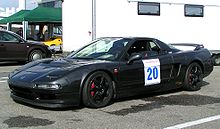
Race modified NSX in the paddock of the Hockenheimring
[edit] Safety car
Since the beginning of the NSX's production, the car has been used as a safety car at the Suzuka Circuit, even for the Japanese Grand Prix in its early years of production, and is still used at the circuit. The car is also used for the same role at Twin Ring Motegi, the other circuit owned by Honda.[edit] 24 Hours of Le Mans
The NSX made three appearances at the 24 Hours of Le Mans, in 1994, 1995, and 1996.Three Honda NSXs were entered in the 1994 24 Hours of Le Mans. Cars numbers 46, 47 and 48 were prepared and run by team Kremer Racing Honda, with Team Kunimitsu assisting and driving the number 47 car. All were in the GT2 class, and all completed the race, but placed 14th, 16th and 18th.[20]
Three Honda NSXs were entered in the 1995 24 Hours of Le Mans. Honda's factory team brought two turbocharged NSXs which were entered in the GT1 class numbered 46 and 47. Team Kunimitsu Honda prepared and entered a naturally-aspirated NSX into the GT2 class numbered 84. Car 46 finished but was not classified for failing to complete 70% of the distance of the race winner. Car 47 did not finish due to clutch and gearbox failure. Car 84, driven by Keiichi Tsuchiya, Akira Iida, and Kunimitsu Takahashi, placed 8th overall and first in the GT2 class after completing 275 laps. This NSX was featured in the original Gran Turismo.[21]
For the 1996 24 Hours of Le Mans, only the Team Kunimitsu Honda NSX returned with the same drivers. It completed 305 laps to finish in the 16th position overall, and third in the GT2 class.[22]
[edit] Super GT
For use in the Super GT (formerly the JGTC), the NSX has been highly modified (as allowed by series technical regulations) with chassis development by Dome, engine development by Mugen, for Honda.Externally the NSX shape has developed race by race, season to season to the demands of increasing aerodynamic downforce within the regulations. The most notable change is the position of the V6 engine, which is mounted longitudinally instead of transversely as per the roadcar. Similar to the setup used in modern Lamborghinis, the gearbox is located in the center tunnel under the cockpit and is connected to the rear differential by a driveshaft. Engines can either be turbocharged or naturally aspirated, depending on the class and on the rules.
Prior to rule changes beginning in the 2003 season, the Super GT/GT500 NSX was powered by a specially modified version of the C32B V6 engine. Using a stroker crankshaft from Toda Racing, the naturally-aspirated engine displaced 3.5 liters and produced nearly 500 bhp. Beginning in 2003, Honda substituted a highly-modified C30A, augmented by a turbocharger, which also produces up to 500 bhp.
The NSX continued to be used as the works Honda car in the GT500 class, even though it is no longer in production, until it was replaced in 2010 with the HSV-010.
[edit] Honda NSX Super GT specifications
Year 2009 final specification- Chassis: Carbon fiber reinforced aluminum frame, steel Roll cage, JAF approval.
- Engine: Custom-built Honda engine, water-cooled V6 Normally aspirated (Longitudial-mounted), 3.494 liters, DOHC, 4-valves per cylinder.
- Speed:191 (mph).
- Fuel: ENEOS unleaded 100 RON gasoline.
- Lubrication: Mobil 1, BP, MOTUL, Elf.
- Fuel delivery: Fuel injection.
- Wheelbase: 2530 mm.
- Length: 4610 mm.
- Width: 2000 mm.
- Weight: Over 1120 kg.
- Fuel capacity: 100 Litres.
- Clutch: AP C/C 5.5" 4 plates pull.
- Brakes: Alcon, Performance Friction.
- Springs and dampers: Showa Double wishbone inboard type.
- Gearbox: Hewland 6-speed sequential.
- Spark plugs: NGK.
- Wheel rims: RAYS Engineering, BBS F: 13J-18, R: 13J-17.
- Tires: Bridgestone, Dunlop F: 330/40 R18 , R: 330/45 R17 radial slick/treaded rain tires.
- Intake air restrictor: 29.1 mm × 2mm.
- Safety equipment: TAKATA 5-point seatbelt, HANS Device.
- Team: Autobacs Racing Team Aguri, Dome Racing, Nakajima Racing, Real Racing, Team Kunimitsu.
source:wikipedia.com

